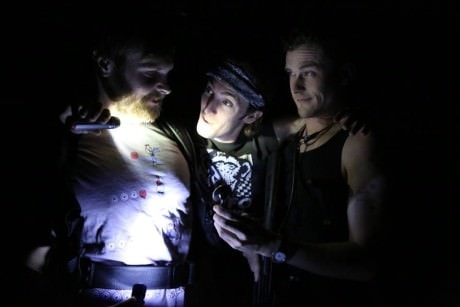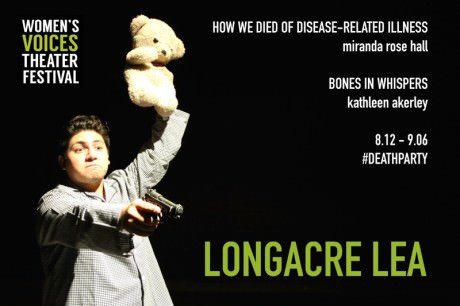The eagerly anticipated Women’s Voices Theatre Festival kicked off with the opening of Longacre Lea’s production of two world-premiere one-acts, which the company collectively dubs #DeathParty. The plays are stylistically distinct but share a cast and have an intriguing thematic kinship: Both tap into the anxious zeitgeist about global contagion and human extinction. Prescience? Paranoia? Therein lies the nub of these two idiosyncratic takes on our fate.
The first, How We Died of Disease-Related Illness by Yale MFA Candidate Miranda Rose Hall, treats us to a zany absurdist comedy set in a hospital where manic efforts to halt a virulent disease fail hilariously. The running joke is that the disease turns human organs into avocados and anyone afflicted with the disease spews guacamole from some orifice. Fluffly neon-green tulle and lacy ribbons represent the guac, which accumulates in piles as one character after another comically excretes.
The actors’ gimlet-eyed sight gags and the author’s off-kilter text trigger intermittent giggles. (Random sample: “It’s okay to wash only one hand if you only use one hand.”) The play’s pace takes a while to hit its comic stride, but it grows on you (no medical pun intended). As its momentum mounts, How We Died of Disease-Related Illness becomes a wacky, madcap farce that sends up our collective hypochondria. The effect is like a prophylactic for our fears we live in plague years.
The eleven energetic actors cast in both plays include two especially funny standouts in this one: Ashley DeMain as Trisha starts the show as a janitor, assiduously sweeping the floor and scrubbing everything down. Episodically she reappears in a series of higher-ranking jobs (her turn as a sanctimonious clergyperson particularly tickled me). And Tia Shearer as Lisa drops in (literally, through the ceiling) wielding a machete. Her fierce, athletic, wide-eyed turn as a Rambo-lette hellbent on martyrdom totally embodied absurdism and stole scene after scene. (The audience roared when she told of the organization she founded to save CLITS—Cats Living in Tragic Situations.)

The second play, Bones in Whispers by Longacre Lea Founder Kathleen Akerley, takes a tack on the topic that is darker, more surreal. Humanity is in the throes of a mass die-off and rival marauding bands have descended on an abandoned hospital in hopes of survival. The play begins in darkness as militiapeople armed with guns and flashlights storm the stage, shouting back and forth, and it feels like an apocalyptic sci-fi action flick (albeit crammed into a cramped space). The walls exude a foul-smelling miasma; a disembodied voice sings forth from the mouth of a corpse. The invaders repetitively do a dance that they believe protects them from dying.
The title, lifted from a line in T. S. Eliot’s The Waste Land, hints at the heady badinage we’re to hear. (Random sample: “We are operating in a reality where everything has changed. Nothing means the same.”) A signature of Ackerley’s scripts is a combo of the clever and recondite with playful pop-culture genre-bending (aptly her company’s tagline is “physical productions of cerebral works”).
Originally Akerley solicited a play for the Women’s Voices Theatre Festival from Hall, who submitted two, and Akerley chose How We Died of Disease-Related Illness. In part in response, and in part to fill an evening, Akerley then wrote Bones in Whispers, which like Hall’s work takes a while to grow on you. The plot, which somewhat eluded me, propels some eye-popping scenic effects and language that flies by at a head-spinning pace. By the end is revealed—in a spectacular show of stagecraft—a metaphor for our species’s destiny that is mindblowing.

Matthew Alan Ward’s agile and expressive performance as Joel, a medical orderly and PT patient, was especially arresting. And the ensemble as a whole—which also included Christine Alexander, Tom Carman, Tamieka Chavis, Vince Eisenson, Séamus Miller, Alejandro Ruiz, Amal Saade, and Jorge A. Silva—was much to be enjoyed.
Akerley directed both shows briskly and designed a multifunction set that served both scripts equally. She also choreographed the fun-to-watch ritual dance routine. Gail Stewart Beach’s costumes were imaginative, and John Burkland’s lighting electrified many a moment.
A question that lingered for me afterward, on the occasion of WVTF’s debut production, was this: Exactly what about these two plays distinguishes them as being women’s voices other than the fact that both authors are women? As I mulled the question, nothing leapt to mind as the definitive answer. Which may be the point. To say more plays by women ought to be staged in town—as WVTF correctly makes no bones about—is not to say what those plays should or should not say or be about. And so if Longacre Lea chooses to celebrate equal opportunity for ungendered absurdism and surrealism unburdened by sexual political agendas, then why not play along—and come to its lively #DeathParty?
Running Times: About 80 minutes for each play, with a 10-minute intermission.
#DeathParty: How We Died of Disease-Related Illness and Bones in Whispers plays through September 6, 2015, at Longacre Lea performing at Catholic University’s Callan Theatre – 3801 Harewood Road, NE, in Washington, DC. For tickets, call (202) 460-2188, or purchase them online.
RATING:






